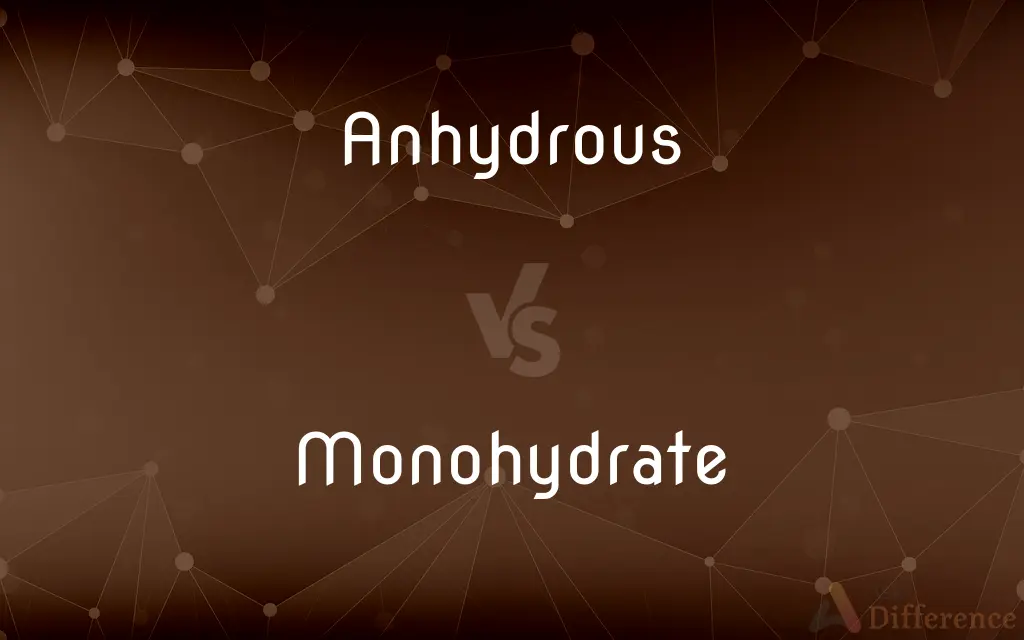Anhydrous vs. Monohydrate — What's the Difference?
Edited by Tayyaba Rehman — By Fiza Rafique — Updated on October 10, 2023
Anhydrous refers to substances devoid of water, while monohydrate denotes compounds containing one molecule of water.

Difference Between Anhydrous and Monohydrate
Table of Contents
ADVERTISEMENT
Key Differences
Both "anhydrous" and "monohydrate" pertain to the presence or absence of water in chemical compounds, but they indicate different states. Anhydrous, derived from the Greek words "an," meaning without, and "hydor," meaning water, refers to substances that are without water or have had their water content removed. This can be particularly relevant in contexts like chemical reactions where the presence of water may interfere with the desired outcome. For instance, anhydrous conditions are maintained in certain reactions to ensure the accuracy of results.
On the contrary, monohydrate represents a specific state of hydration. When a substance is labeled as a monohydrate, it indicates that the compound contains a single water molecule. This is commonly seen in salts and other crystalline materials that can form hydrates. These compounds can often exist both in hydrated forms and anhydrous forms, with the monohydrate structure being a specific state of hydration.
For example, consider copper sulfate, a common chemical compound. It can exist as an anhydrous form, which is a white powder. But, when exposed to moisture, it can incorporate water into its structure and turn into copper sulfate monohydrate with a distinct blue color.
It's essential to understand the distinction between anhydrous and monohydrate forms as they can have different properties. The presence or absence of water can influence a substance's solubility, reactivity, color, and even its crystalline structure. Moreover, switching between these forms, like removing water from a monohydrate to get an anhydrous compound or vice versa, can require specific conditions.
In summary, while both terms relate to the concept of water content in substances, anhydrous emphasizes the complete absence of water, and monohydrate underscores the inclusion of one water molecule in the compound's structure.
ADVERTISEMENT
Comparison Chart
Meaning
Without water
Contains one molecule of water
Water Content
0%
Specific to one molecule per formula unit of the compound
Common Usage
In reactions requiring absence of water
In crystalline materials that incorporate water
Physical Properties
Can differ from hydrated forms
Properties can differ from both anhydrous and other hydrates
Conversion
Can often be converted to hydrates with moisture
Can often be converted to anhydrous form by dehydration
Compare with Definitions
Anhydrous
Anhydrous can mean devoid of moisture.
The sample was stored in an anhydrous environment.
Monohydrate
Monohydrate refers to a compound containing one molecule of water.
The salt crystallized as a monohydrate from the solution.
Anhydrous
Anhydrous refers to a substance lacking water.
The anhydrous form of the salt was used in the reaction.
Monohydrate
Monohydrate can describe a compound's unique physical properties.
The monohydrate version of the material exhibited a different color.
Anhydrous
Anhydrous denotes a condition necessary for certain reactions.
To prevent unwanted side reactions, an anhydrous solvent was used.
Monohydrate
Monohydrate denotes a specific hydrated state of a substance.
The compound can exist as both an anhydrous form and a monohydrate.
Anhydrous
Anhydrous implies a specific state of a compound.
The blue crystals turned white upon becoming anhydrous.
Monohydrate
Monohydrate implies the inclusion of water in crystalline structures.
Under certain conditions, the salt prefers to form a monohydrate.
Anhydrous
A substance is anhydrous if it contains no water. Many processes in chemistry can be impeded by the presence of water; therefore, it is important that water-free reagents and techniques are used.
Monohydrate
Monohydrate suggests a balance between water content and compound.
Upon adding water, the anhydrous substance transitioned to its monohydrate form.
Anhydrous
Without water, especially water of crystallization.
Monohydrate
A compound, such as calcium chloride monohydrate, CaCl2·H2O, that contains one molecule of water of hydration.
Anhydrous
Having little or no water.
Monohydrate
(chemistry) A hydrate whose solid contains a single molecule of water of crystallization per molecule, or per unit cell
Anhydrous
(chemistry) Having no water of crystallization.
Monohydrate
A hydrate that contains one molecule of water per molecule of the compound
Anhydrous
Destitute of water; as, anhydrous salts or acids.
Anhydrous
Without water; especially without water of crystallization
Anhydrous
Anhydrous suggests a dehydrated form of a substance.
He heated the material to obtain its anhydrous version.
Common Curiosities
Can a monohydrate become anhydrous?
Yes, by removing the incorporated water molecule, typically through heating or other dehydration methods.
Is every hydrate a monohydrate?
No, hydrates can have varying numbers of water molecules. A monohydrate has one, but there are also dihydrates, trihydrates, etc.
Why is it important to store anhydrous compounds properly?
Exposure to moisture can change their properties and potentially their effectiveness in specific applications.
Can both anhydrous and monohydrate forms of a compound coexist?
Typically, under given conditions, one form will be more stable, but transient states or mixtures can exist during transformations.
How can I determine if a substance is a monohydrate?
Analytical methods, like gravimetric analysis, can help determine water content in a substance.
Can a monohydrate be rehydrated after becoming anhydrous?
Yes, many compounds can reincorporate water to revert to their monohydrate form under the right conditions.
Does anhydrous mean the same as dry?
Essentially, yes. Anhydrous refers to the absence of water, so it means "dry" in the context of water content.
Why might a chemist use an anhydrous solvent?
Some reactions are sensitive to water, so anhydrous solvents prevent unwanted side reactions.
Can an anhydrous compound absorb moisture from the air?
Yes, some anhydrous compounds are hygroscopic and can absorb moisture, becoming a hydrate.
Are the physical properties of anhydrous and monohydrate forms the same?
No, they can differ in aspects like color, solubility, and crystalline structure.
Are anhydrous compounds always solids?
No, while many are solids, anhydrous compounds can also exist as liquids or gases.
Does "monohydrate" mean the compound is dissolved in water?
No, it means the compound has incorporated one molecule of water into its structure.
Is the water in a monohydrate chemically bonded to the compound?
The water is typically associated through weaker interactions, like hydrogen bonding, rather than strong chemical bonds.
Are all anhydrous substances white?
No, anhydrous substances can come in various colors, depending on their chemical nature.
Can anhydrous conditions be harmful?
Yes, extremely anhydrous conditions can be harmful to biological tissues, like skin, due to dehydration effects.
Share Your Discovery

Previous Comparison
Hurricane vs. Blizzard
Next Comparison
Exine vs. IntineAuthor Spotlight
Written by
Fiza RafiqueFiza Rafique is a skilled content writer at AskDifference.com, where she meticulously refines and enhances written pieces. Drawing from her vast editorial expertise, Fiza ensures clarity, accuracy, and precision in every article. Passionate about language, she continually seeks to elevate the quality of content for readers worldwide.
Edited by
Tayyaba RehmanTayyaba Rehman is a distinguished writer, currently serving as a primary contributor to askdifference.com. As a researcher in semantics and etymology, Tayyaba's passion for the complexity of languages and their distinctions has found a perfect home on the platform. Tayyaba delves into the intricacies of language, distinguishing between commonly confused words and phrases, thereby providing clarity for readers worldwide.














































